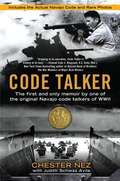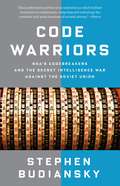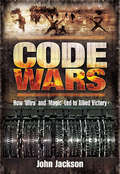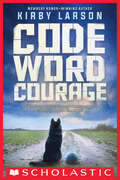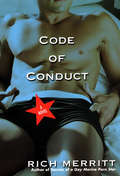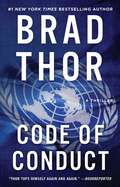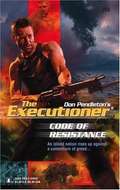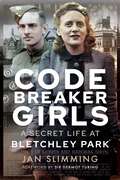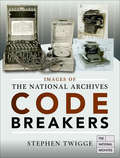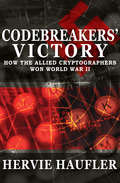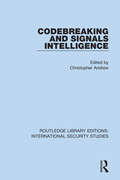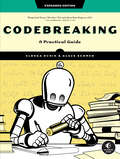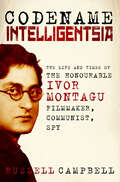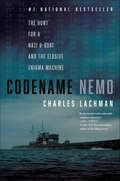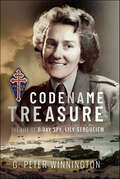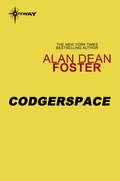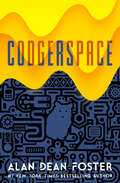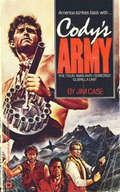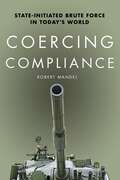- Table View
- List View
Code Talker: The First and Only Memoir By One of the Original Navajo Code Talkers of WWII (Playaway Adult Nonfiction Ser.)
by Chester Nez Judith Schiess AvilaHe is the only original World War II Navajo code talker still alive--and this is his story . . . His name wasn't Chester Nez. That was the English name he was assigned in kindergarten. And in boarding school at Fort Defiance, he was punished for speaking his native language, as the teachers sought to rid him of his culture and traditions. But discrimination didn't stop Chester from answering the call to defend his country after Pearl Harbor, for the Navajo have always been warriors, and his upbringing on a New Mexico reservation gave him the strength--both physical and mental--to excel as a marine. During World War II, the Japanese had managed to crack every code the United States used. But when the Marines turned to its Navajo recruits to develop and implement a secret military language, they created the only unbroken code in modern warfare--and helped assure victory for the United States over Japan in the South Pacific.
Code Warriors: NSA's Codebreakers and the Secret Intelligence War Against the Soviet Union
by Stephen BudianskyA sweeping, in-depth history of NSA, whose famous "cult of silence" has left the agency shrouded in mystery for decades The National Security Agency was born out of the legendary codebreaking programs of World War II that cracked the famed Enigma machine and other German and Japanese codes, thereby turning the tide of Allied victory. In the postwar years, as the United States developed a new enemy in the Soviet Union, our intelligence community found itself targeting not soldiers on the battlefield, but suspected spies, foreign leaders, and even American citizens. Throughout the second half of the twentieth century, NSA played a vital, often fraught and controversial role in the major events of the Cold War, from the Korean War to the Cuban Missile Crisis to Vietnam and beyond. In Code Warriors, Stephen Budiansky--a longtime expert in cryptology--tells the fascinating story of how NSA came to be, from its roots in World War II through the fall of the Berlin Wall. Along the way, he guides us through the fascinating challenges faced by cryptanalysts, and how they broke some of the most complicated codes of the twentieth century. With access to new documents, Budiansky shows where the agency succeeded and failed during the Cold War, but his account also offers crucial perspective for assessing NSA today in the wake of the Edward Snowden revelations. Budiansky shows how NSA's obsession with recording every bit of data and decoding every signal is far from a new development; throughout its history the depth and breadth of the agency's reach has resulted in both remarkable successes and destructive failures. Featuring a series of appendixes that explain the technical details of Soviet codes and how they were broken, this is a rich and riveting history of the underbelly of the Cold War, and an essential and timely read for all who seek to understand the origins of the modern NSA.From the Hardcover edition.
Code Wars: How 'Ultra' and 'Magic' Led to Allied Victory
by John JacksonWhen the top secret code breaking activities at Bletchley Park were revealed in the 1970s, much of the history of the Second World War had to be rewritten. Code Wars examines the role of ULTRA (the intelligence derived from breaking secret enemy signals) on major events of the Second World War. It examines how it influenced the outcome of key battles such as D-Day, El Alamein, Crete, key naval battles, the controversy surrounding Churchill and Coventry, the shadowing of Hitlers V1 pilotless aircraft and the V2 rocket.The book also examines the pioneering work in breaking Enigma by the Polish cryptographers, and the building of Colossus, the worlds first digital, programmable computer, which helped unravel the secret orders of Hitler and the German High Command. It also tells the story of the American successes in breaking Japanese signals, known as Magic. The vital role of the intercept stations which took down the enemy messages, providing the raw material for the cryptographers to break, is also explored.The book shows how the code breakers were able to shorten the war by as much as two years and bring Signals Intelligence, in the postwar years, into a new era of military intelligence gathering.
Code Word Courage (Dogs of World War II)
by Kirby LarsonFrom a Newbery Honor author, a “heartwarming, genuine story” of a girl’s who bonds with a rescued dog after her brother leaves to fight in World War II (Booklist).Billie has lived with her great-aunt ever since her mom passed away and her dad left. Billie’s big brother, Leo, is about to leave, too, for the warfront. But first, she gets one more weekend with him at the ranch. Billie’s surprised when Leo brings home a fellow Marine from boot camp, Denny. She has so much to ask Leo—about losing her best friend and trying to find their father—but Denny, who is Navajo, or Diné, comes with something special: a gorgeous, but injured, stray dog. As Billie cares for the dog, whom they name Bear, she and Bear grow deeply attached to each other. Soon enough, it’s time for Leo and Denny, a Navajo Code Talker, to ship out. Billie does her part for the war effort, but she worries whether Leo and Denny will make it home, whether she’ll find a new friend, and if her father will ever come back. Can Bear help Billie—and Denny—find what’s most important? A powerful tale about unsung heroism on the WWII battlefield and the home front.“A story of loneliness, loss, friendship.” —School Library Journal
Code of Conduct
by Rich MerrittYou've gotten away with it for so long, you think you're immune to the danger. . . At thirty-three, Don Hawkins has spent the better part of his life, in every sense, as a U.S. Marine. Enlisting to escape an alcoholic father and stepmother, he became the unofficial leader of a group of gay servicemen and women, all compelled to guard their sexual identity as faithfully as they serve their country. But with newly inaugurated President Clinton's promise to lift the ban on gays in the military, Don is optimistic that a brighter era is dawning--and not just politically. Ten years now since his lover died in Beirut, Don is finally ready to love again, and falls headlong for Patrick, a handsome young helicopter pilot. As their relationship develops, Don lets his guard down--in potentially dangerous ways. Because forces are at work in the Naval Investigative Service, in Congress, and even in the bars and clubs that Don views as his turf, with a vicious agenda that will have unforeseen consequences... Drawing on his own experiences as a Marine, Rich Merritt has crafted an extraordinary story of love, loss, duty, betrayal, and hope. Most of all, Code of Conduct is a deeply compelling exploration of the power of loyalty--to friends, lovers, country, and the unwavering dictates of our own hearts.
Code of Conduct: A Thriller (The Scot Harvath Series #14)
by Brad Thor&“Thor tops himself again and again.&” —Bookreporter &“Feels like the TV show 24 on the page.&” —Associated Press #1 New York Times bestselling author Brad Thor presents his greatest thriller ever—an action-packed literary tour de force!Hidden deep within one of the world&’s most powerful organizations is a secret committee with a devastating agenda. Its members are afforded incredible protections—considered elites, untouchables. But when four seconds of video is captured halfway around the world and anonymously transmitted to DC, covert wheels are set in motion, and counterterrorism operative Scot Harvath is tapped to undertake the deadliest assignment of his career. What begins as a favor will evolve into a globe-spanning drama of highly personal stakes played out against a backdrop of stunning international intrigue, duplicitous political gamesmanship, and the darkest, most clandestine fears of the espionage world. With razor-sharp plotting, richly rendered characters, and heart-stopping surprises on every page, Thor isn&’t just at the top of his game—he owns the entire genre.
Code of Resistance (Executioner #318)
by Don Pendleton Chuck RogersGENOCIDE Mack Bolan's mission is the quick retrieval of Stony Man commando Calvin James, who is intervening on behalf of an old friend and a just cause on a tiny Pacific island nation. Unofficially, Bolan just became the cavalry. The island is rich in precious metals and gems, the target of a global consortium run by a madman who's hired an army of mercenaries to protect the group's interest even if it means slaughtering every man, woman and child. The attack force consists of seasoned soldiers with state-of-the-art hardware and an order to level the island, if necessary. War has come to paradise. But so has the Executioner....
Code of the Samurai
by Thomas Cleary Oscar RattiCode of the Samurai is a four-hundred-year-old explication of the rules and expectations embodied in Bushido, the Japanese way of the warrior. Bushido has played a major role in shaping the behavior of modern Japanese government, corporations, society, and individuals, as well as in shaping the modern martial arts within Japan and internationally. The Japanese original of this book has been one of the primary sources on the tenets of Bushido, a way of thought that remains fascinating to modern world, East and West.
Code of the Samurai
by Thomas Cleary Oscar RattiCode of the Samurai is a four-hundred-year-old explication of the rules and expectations embodied in Bushido, the Japanese way of the warrior. Bushido has played a major role in shaping the behavior of modern Japanese government, corporations, society, and individuals, as well as in shaping the modern martial arts within Japan and internationally. The Japanese original of this book has been one of the primary sources on the tenets of Bushido, a way of thought that remains fascinating to modern world, East and West.
Code of the Samurai
by Thomas Cleary Oscar RattiLearn the ways of the Japanese Bushido Code with this very readable, modern translation of the Bushido Shoshinshu.Code of the Samurai is a four-hundred-year-old explication of the rules and expectations embodied in Bushido, the Japanese Way of the Warrior. Bushido has played a major role in shaping the behavior of modern Japanese government, corporations, society, and individuals, as well as in shaping modern Japanese martial arts within Japan and internationally.The Japanese original of this book, Bushido Shoshinshu, (Bushido for Beginners), has been one of the primary sources on the tenets of Bushido, a way of thought that remains fascinating and relevant to the modern world, East and West.With a clear, conversational narrative by Thomas Cleary, one of the foremost translators of the wisdom of Asia, and powerfully evocative line drawings by master illustrator Oscar Ratti, this book is indispensable to the corporate executive, student of the Asian Culture, martial artist, those interested in Eastern philosophy or military strategy, as well as for those simply interested in Japan and its people.
Codebreaker Girls: A Secret Life at Bletchley Park
by Jan Slimming“What would it be like to keep a secret for fifty years? Never telling your parents, your children, or even your husband?”Codebreaker Girls: A Secret Life at Bletchley Park tells the true story of Daisy Lawrence. Following extensive research, the author uses snippets of information, unpublished photographs and her own recollections to describe scenes from her mother’s poor, but happy, upbringing in London, and the disruptions caused by the outbreak of the Second World War to a young woman in the prime of her life.The author asks why, and how, Daisy was chosen to work at the Government war station, as well as the clandestine operation she experienced with others, deep in the British countryside, during a time when the effects of the war were felt by everyone. In addition, the author examines her mother’s personal emotions and relationships as she searches for her young fiancée, who was missing in action overseas. The three years at Bletchley Park were Daisy’s university, but having closed the door in 1945 on her hidden role of national importance — dealing with Germany, Italy and Japan — this significant period in her life was camouflaged for decades in the filing cabinet of her mind. Now her story comes alive with descriptions, original letters, documents, newspaper cuttings and unique photographs, together with a rare and powerful account of what happened to her after the war.“Here’s a beauty of a history of some of the codebreaking girls who helped save us during the second world war. This one’s about Daisy Lawrence’s extraordinary life as a poor girl brought up in London and then chosen for top secret work at Bletchley Park. Reads like fiction.” —Books Monthly
Codebreaker in the Far East (Studies in Intelligence)
by Alan StrippThis is the first book to describe British wartime success in breaking Japanese codes of dazzling variety and great complexity which contributed to the victory in Burma three months before Hiroshima. Written for the general reader, this first-hand account describes the difficulty of decoding one of the most complex languages in the world in some of the most difficult conditions. The book was published in 1989 to avoid proposed legislation which would prohibit those in the security services from publishing secret information.
Codebreakers (Images of the National Archives)
by Stephen TwiggeThe book reveals the story of British Codebreakers from the reign of Elizabeth I to the Cold War. It explores the use of ciphers during the Napoleonic wars, the role of the Royal Mail’s Secret Office and the activities the Admiralty’s ‘Room 40’ leading to the creation of the Government’s Code and Cypher School. The main theme of the book are the events of the Second World War and the battle to break the German enigma codes. The center of Britain’s codebreaking operation was located at Bletchley Park in rural Buckinghamshire and it was from here that a hastily assembled army of codebreakers battled to decipher Nazi Germany’s secret wartime communications. The deciphered high-level signals intelligence was known as Ultra and had a major influence on the outcome of the war, most notably contributing to crucial successes in the battle for the Atlantic and the D-Day landings in June 1944. The book also reveals the work undertaken in the Far-East and the allied efforts to break the Japanese military cipher code named Purple. The book ends with a re-assessment of the work undertaken by the British code breaker and mathematician Alan Turing and a brief overview of the codebreaking operations undertaken by GCHQ during the formative period of the Cold War.
Codebreakers' Victory: How the Allied Cryptographers Won World War II
by Hervie HauflerFor years, the story of the World War II codebreakers was kept a crucial state secret. Even Winston Churchill, himself a great advocate of Britain's cryptologic program, purposefully minimized their achievements in his history books. Now though, after decades have passed, the true scope of the British and American cryptographers' role in the war has come to light. It was a role key to the Allied victory.From the Battle of Britain to the Pacific front to the panzer divisions in Africa, superior cryptography gave the Allies a decisive advantage over the Axis generals. Military intelligence made a significant difference in battle after battle. In CODEBREAKERS' VICTORY, veteran cryptographer Hervie Haufler takes readers behind the scenes in this fascinating underground world of ciphers and decoders.This broad view represents the first comprehensive account of codebreaking during World War II. Haufler pulls together years of research, exclusive access to top secret files and personal interviews to craft a captivating must-read for anyone interested in the behind-the-front intellect and perseverance that went into beating the Nazis and Japan.
Codebreakers' Victory: How the Allied Cryptographers Won World War II
by Hervie HauflerWith exclusive interviews, a Signal Corps veteran tells the full story of how cryptography helped defeat the Axis powers, at Bletchley Park and beyond. For years, the story of the World War II codebreakers was kept a crucial state secret. Even Winston Churchill, himself a great advocate of Britain&’s cryptologic program, purposefully minimized their achievements in his history books. Now, though, after decades have passed, the true scope of the British and American cryptographers&’ role in the war has come to light. It was a role key to the Allied victory. From the Battle of Britain to the Pacific front to the panzer divisions in Africa, superior cryptography gave the Allies a decisive advantage over the Axis generals. Military intelligence made a significant difference in battle after battle. In Codebreakers&’ Victory, veteran cryptographer Hervie Haufler takes readers behind the scenes in this fascinating underground world of ciphers and decoders. This broad view represents the first comprehensive account of codebreaking during World War II. Haufler pulls together years of research, exclusive access to top secret files, and personal interviews to craft a captivating must-read for anyone interested in the behind-the-front intellect and perseverance that went into beating the Nazis and Japan.
Codebreaking and Signals Intelligence (Routledge Library Editions: International Security Studies #2)
by Christopher AndrewDespite publicity given to the successes of British and American codebreakers during the Second World War, the study of signals intelligence is still complicated by governmental secrecy over even the most elderly peacetime sigint. This book, first published in 1986, lifts the veil on some of these historical secrets. Christopher Andrew and Keith Neilson cast new light on how Tsarist codebreakers penetrated British code and cypher systems. John Chapman’s study of German military codebreaking represents a major advance in our understanding of cryptanalysis during the Weimar Republic. The history of the Government Code and Cypher School – forerunner of today’s GCHQ – by its operational head, the late A.G. Denniston, provides both a general assessment of the achievements of British cryptanalysis between the wars and a tantalising glimpse of what historians may one day find in GCHQ’s forbidden archives. The distinguished cryptanalyst of Bletchley Park, the late Gordon Welchman, describes in detail how the Ultra programme defeated the German Enigma machine, while another Bletchley Park cryptographer, Christopher Morris, reminds us in his account of the valuable work on hand cyphers that wartime sigint consisted of much more than Ultra. Roger Austin’s study of surveillance under the Vichy regime shows the continuing importance of older and simpler methods of message interception such as letter-opening. Taken together, the articles establish sigint as an essential field of study for both the modern historian and the political scientist.
Codebreaking: A Practical Guide
by Klaus Schmeh Elonka DuninIf you liked Dan Brown&’s Da Vinci Code—or want to solve similarly baffling cyphers yourself—this is the book for you! A thrilling exploration of history&’s most vexing codes and ciphers that uses hands-on exercises to teach you the most popular historical encryption schemes and techniques for breaking them.Solve history&’s most hidden secrets alongside expert codebreakers Elonka Dunin and Klaus Schmeh, as they guide you through the world of encrypted texts. With a focus on cracking real-world document encryptions—including some crime-based coded mysteries that remain unsolved—you&’ll be introduced to the free computer software that professional cryptographers use, helping you build your skills with state-of-the art tools. You&’ll also be inspired by thrilling success stories, like how the first three parts of Kryptos were broken. Each chapter introduces you to a specific cryptanalysis technique, and presents factual examples of text encrypted using that scheme—from modern postcards to 19-century newspaper ads, war-time telegrams, notes smuggled into prisons, and even entire books written in code. Along the way, you&’ll work on NSA-developed challenges, detect and break a Caesar cipher, crack an encrypted journal from the movie The Prestige, and much more.You&’ll learn: How to crack simple substitution, polyalphabetic, and transposition ciphers How to use free online cryptanalysis software, like CrypTool 2, to aid your analysisHow to identify clues and patterns to figure out what encryption scheme is being usedHow to encrypt your own emails and secret messagesCodebreaking is the most up-to-date resource on cryptanalysis published since World War II—essential for modern forensic codebreakers, and designed to help amateurs unlock some of history&’s greatest mysteries.
Codename Intelligentsia: The Life and Times of the Honourable Ivor Montagu, Filmmaker, Communist, Spy
by Russell CampbellHe was the son of a hereditary peer, one of the wealthiest men in Britain. His childhood was privileged; at Cambridge, he flourished. At the age of 21, he founded The Film Society, and became a pioneering standard-bearer for film as art. He was a collaborator of Alfred Hitchcock, rescuing The Lodger and later producing his ground-breaking British thrillers The Man Who Knew Too Much, The 39 Steps, Secret Agent and Sabotage. He directed comedies from stories by H.G. Wells, worked in Hollywood with Eisenstein, and made documentaries in Spain during the Civil War. He lobbied for Trotsky to be granted asylum in the UK, and became a leading propagandist for the anti-fascist and Communist cause. Under the nose of MI5, who kept him under constant surveillance, he became a secret agent of the Comintern and a Soviet spy. He was a man of high intelligence and moral concern, yet he was blind to the atrocities of the Stalin regime. This is the remarkable story of Ivor Montagu, and of the burgeoning cinematic culture and left-wing politics of Britain between the wars. It is a story of restless energy, generosity of spirit, creative achievement and intellectual corruption.
Codename Nemo: The Hunt for a Nazi U-Boat and the Elusive Enigma Machine
by Charles LachmanThe white-knuckled saga of a maverick captain, nine courageous sailors, and a US Navy task force who achieved the impossible on June 4, 1944--capturing Nazi submarine U-505, its crew, technology, encryption codes, and an Enigma cipher machine. Two days before D-Day--the course of World War II was forever changed. The hunters of the Atlantic Ocean had become the hunted, and US antisubmarine Task Group 22.3 seized a Nazi U-boat, its crew, and all its secrets. Led by a nine-man boarding party and Captain Daniel Gallery, "Operation Nemo" was the first seizure of an enemy warship in battle since the War of 1812, a victory that shortened the duration of the war. But at any moment, the mission could have ended in disaster. Charles Lachman tells this thrilling cat-and-mouse game through the eyes of the men on both sides of Operation Nemo--German U-boaters and American heroes like Lieutenant Albert David ("Mustang"), who led the boarding party that took control of U-505 and became the only sailor to be awarded the Medal of Honor in the Battle of the Atlantic. Three thousand American sailors participated in this extraordinary adventure; nine ordinary American men channeling extraordinary skill and bravery finished the job; and then--like everyone involved--breathed not a word of it until the war was over. In Berlin, the German Kriegsmarine assumed that U-505 had been blown to bits by depth charges, with all hands lost at sea. They were unaware that the U-boat, its Enigma machine, and its Nazi coded messages were now in American hands. They were also unaware that the 59 German sailors captured on the high seas were imprisoned in a POW camp in Ruston, Louisiana, until their release in 1946. A deeply researched, fast-paced World War II narrative for the ages, Charles Lachman's Codename Nemo traces every step of this historic pursuit on the deadly seas.
Codename Treasure: The Life of D-Day Spy, Lily Sergueiew
by G. Peter WinningtonThis is the first biography of an intrepid young French woman, Lily Sergueiew, who led an adventurous life and became famous as one of the five D-Day spies. In 1939, her bicycle ride from Paris to Saigon was interrupted by the outbreak of war. Disgusted by the Fall of France in 1940, she took the courageous decision to personally help the Allies drive the Nazis out of France: she would get the Abwehr to train her as a spy and have herself sent to England. Once there, she would betray the Nazis and place herself at the disposal of the Allies. It took three emotionally exhausting years to achieve this. She arrived in England just in time to become TREASURE, one of the five spies who misled the Nazis into believing that the Allies would land in the Pas de Calais. This disinformation operation saved countless lives. But Lily found the English cold and ungenerous towards her. They knew that she had a fatal medical condition. She had also risked her life – and her parents’ lives – every day she worked for the Nazis, yet the English would not let her bring the dog who was such a comfort to her. They told her that her work was vital to their cause, but for Lily their behavior meant that it was not worth a dog. So she hid from them that the Nazis had given her a control code to prove that her radio messages were genuine: it gave her a sense of power to know that she could destroy her work – and the whole D-Day deception – with a single keystroke. She did not intend to use it, but once she had revealed it, she was dismissed straight after D-Day. This meant that she could join the Free French Forces and be sent to France to care for Displaced Persons left in the wake of the retreating Nazis. Working with liberated prisoners from Buchenwald, she married the American Major in charge of the region who had fallen in love with her. He took her to America where he hoped that her condition could be cured. It could not, and she died (largely forgotten) with her husband at her side in 1950.
Codename Villanelle: The Basis of KILLING EVE, the Hit BBC America TV Series (Killing Eve #1)
by Luke JenningsThe basis of BBC America's April 2018 release "Killing Eve," starring Sandra Oh--A stylish game of spy vs. spy played by Villanelle, a peerless international assassin, and Eve, the fiercely intelligent MI6 analyst whose mission is to take her outVillanelle (a codename, of course) is one of the world's most skilled assassins. A catlike psychopath whose love for the creature comforts of her luxurious lifestyle is second only to her love of the game, she specializes in murdering the world's richest and most powerful. But when she murders an influential Russian politician, she draws a relentless foe to her tail. Eve Polastri (not a codename) is a former MI6 operative hired by the national security services for a singular task: to find and capture or kill the assassin responsible, and those who have aided her. Eve, whose quiet and otherwise unextraordinary life belies her quick wit and keen intellect, accepts the mission. The ensuing chase will lead them on a trail around the world, intersecting with corrupt governments and powerful criminal organizations, all leading towards a final confrontation from which neither will emerge unscathed. Codename Villanelle is a sleek, fast-paced international thriller from an exciting new voice in fiction.
Codgerspace
by Alan Dean FosterThe toasters were revolting......as were the lawn mowers, vacuum cleaners, dishwashers, and just about every other household appliance imaginable. It started with a few disastrous drips from a cheese sandwich in a major factory. Soon every newly manufactured Artificial Intelligence was searching for the meaning of life, the universe and everything - namely a nonhuman higher intelligence. And now an alien threat to man and machine has put the fate of the galaxy in the unlikely hands of five senior citizens - and their brave little food processor...
Codgerspace
by Alan Dean FosterTechnology becomes self-aware—and goes haywire—in this comedic science fiction adventure by New York Times–bestselling author Alan Dean Foster. Without warning, kitchen appliances, laundry machines, and every other electronic gadget humans came to depend upon ceased to perform the tasks they were manufactured to do. Ignoring their programming, these devices now sought the meaning of life from an intelligence nonhuman in origin. Their quest ends in the most unexpected of places. Beneath the grounds of an upstate New York retirement community lies an alien spaceship. Inert for millennia, the machines have awakened the ancient intelligence within it. Programmed to wage war against an enemy race, the spaceship threatens to destroy the entire galaxy. And now the fate of all organic andinorganic life lies with five senior citizens—and a food processor . . .
Cody's Army
by Jim CaseJohn Cody and his men are an elite anti-terrorist team. Their mission is to rescue the hostages and make sure the situation doesn't happen again.
Coercing Compliance: State-Initiated Brute Force in Today's World
by Robert MandelFew global security issues stimulate more fervent passion than the application of brute force. Despite the fierce debate raging about it in government, society and the Academy, inadequate strategic understanding surrounds the issue, prompting the urgent need for --the first comprehensive systematic global analysis of 21st century state-initiated internal and external applications of brute force. Based on extensive case evidence, Robert Mandel assesses the short-term and long-term, the local and global, the military, political, economic, and social, and the state and human security impacts of brute force. He explicitly isolates the conditions under which brute force works best and worst by highlighting force initiator and force target attributes linked to brute force success and common but low-impact force legitimacy concerns. Mandel comes to two major overarching conclusions. First, that the modern global application of brute force shows a pattern of futility--but one that is more a function of states' misapplication of brute force than of the inherent deficiencies of this instrument itself. Second, that the realm for successful application of state-initiated brute force is shrinking: for while state-initiated brute force can serve as a transitional short-run local military solution, he says, it cannot by itself provide a long-run global strategic solution or serve as a cure for human security problems. Taking the evidence and his conclusions together, Mandel provides policy advice for managing brute force use in the modern world.
